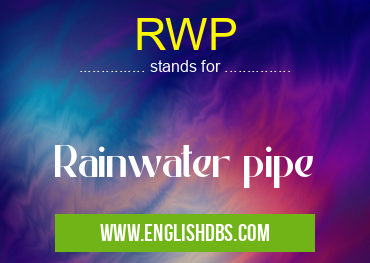What does RWP mean in ENGINEERING
RWP stands for Rainwater Pipe. It is an essential component of a building's plumbing system, designed to collect and safely drain rainwater from the roof. Rainwater pipes play a crucial role in preventing water damage to the building's structure and interior.

RWP meaning in Engineering in Academic & Science
RWP mostly used in an acronym Engineering in Category Academic & Science that means Rainwater pipe
Shorthand: RWP,
Full Form: Rainwater pipe
For more information of "Rainwater pipe", see the section below.
What is an RWP?
An RWP is a vertical pipe that is typically installed along the exterior of a building, often adjacent to a downspout. It collects rainwater from the downspout and directs it towards the ground, preventing it from pooling around the foundation or seeping into the basement. RWPs are typically made from durable materials such as PVC, metal, or concrete to withstand the elements and ensure longevity.
Functions of an RWP
- Water Drainage: RWPs provide a dedicated path for rainwater to flow away from the building. This helps prevent water damage to the roof, walls, and foundation.
- Groundwater Control: By diverting rainwater away from the foundation, RWPs help control groundwater levels around the building. This reduces the risk of flooding and waterlogging.
- Erosion Prevention: RWPs prevent rainwater from eroding the soil around the foundation. This helps maintain the structural integrity of the building and prevents landscaping damage.
- Aesthetics: RWPs can be designed to complement the architectural style of the building. They come in various shapes, sizes, and colors, allowing for aesthetic customization.
Essential Questions and Answers on Rainwater pipe in "SCIENCE»ENGINEERING"
What is a Rainwater Pipe (RWP)?
A rainwater pipe (RWP) is a vertical pipe that collects and channels rainwater from the roof of a building to the ground or a storage tank. It is an essential component of a building's drainage system, preventing water damage to the roof, walls, and foundation.
Why is a RWP Important?
RWPs are crucial for several reasons:
- They prevent water damage to the building by channeling rainwater away from the roof, walls, and foundation.
- They reduce the risk of flooding and waterlogging on the property.
- They contribute to water conservation by collecting rainwater for storage and reuse.
What are the Different Types of RWPs?
RWPs are typically made from materials such as:
- PVC (polyvinyl chloride)
- Galvanized steel
- Copper
- Cast iron
- Concrete Each material offers different advantages and disadvantages, such as durability, cost, and aesthetics.
How to Choose the Right RWP?
Factors to consider when choosing an RWP include:
- Roof size and shape
- Climate conditions
- Drainage requirements
- Building height
- Aesthetics It is advisable to consult with a professional plumber or drainage expert for guidance.
How to Maintain a RWP?
Regular maintenance of RWPs is essential for their proper functioning. This includes:
- Cleaning debris and blockages from gutters and downpipes
- Inspecting for cracks, leaks, or damage
- Repainting or replacing damaged sections as needed
- Ensuring secure connections between pipes and fittings
Final Words: RWPs are vital components of a building's plumbing system, playing a crucial role in rainwater management. They protect the building from water damage, control groundwater levels, prevent erosion, and contribute to the building's overall aesthetics. Proper installation and maintenance of RWPs are essential for ensuring their effective functioning and the long-term integrity of the building.
